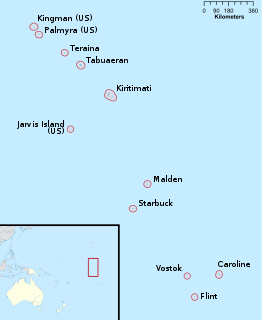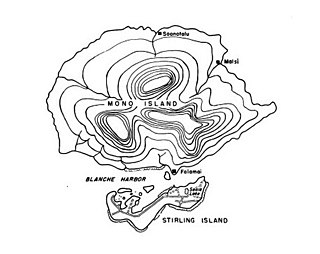Related Research Articles

The Line Islands, Teraina Islands or Equatorial Islands are a chain of 11 atolls and coral islands in the central Pacific Ocean, south of the Hawaiian Islands. The island chain stretches northwest to southeast across 2,350 km (1,460 mi), making it one of the longest island chains in the world. It lies at the geographic center of the Pacific Ocean, near Starbuck Island. One of the atolls in the group, Kiritimati, has the largest land area of any atoll in the world. Of the 11 atolls, all of which were formed by volcanic activity, only the Kiritimati and Tabuaeran atolls and Teraina island have a permanent population. Eight of the atolls are parts of Kiribati. The remaining three—Jarvis Island, Kingman Reef, and Palmyra Atoll—are territories of the United States grouped with the United States Minor Outlying Islands.

The Arctic Archipelago, also known as the Canadian Arctic Archipelago, is an archipelago lying to the north of the Canadian continental mainland, excluding Greenland.

Rennell and Bellona is one of the nine provinces of Solomon Islands, comprising two inhabited atolls, Rennell and Bellona, or Mu Ngava and Mu Ngiki respectively in Rennellese, as well as the uninhabited Indispensable Reef. Rennell and Bellona are both Polynesian-inhabited islands within the predominantly Melanesian Solomons. They are thus considered Polynesian outliers. The first known European to sight the islands was Mathew Boyd of Camberwell, London, commander of the merchant ship, Bellona, in 1793. The province has a combined population of 3,041, the least populous province of Solomon Islands. The Samoic language of the islands is, in English texts, called Rennellese. The province's capital is Tigoa, on Rennell Island.

I-400 was an Imperial Japanese Navy Sentoku-type submarine commissioned in 1944 for service in World War II. Capable of carrying three two-seat Aichi M6A1 "Seiran" float-equipped torpedo bombers, the Sentoku-class submarines were built to launch a surprise air strike against the Panama Canal. Until 1965, the Sentaku-type submarines—I-400 and her sister ships I-401 and I-402 —were the largest submarines ever commissioned.

Mono Island is the largest island of the Treasury Islands, Solomon Islands, at 7°21′S155°34′E.

The Chesterfield Islands are a French archipelago of New Caledonia located in the Coral Sea, 550 km (300 nmi) northwest of Grande Terre, the main island of New Caledonia. The archipelago is 120 km long and 70 km broad, made up of 11 uninhabited islets and many reefs. The land area of the islands is less than 10 km2.
The Gardner family were a group of whalers operating out of Nantucket, Massachusetts, from the seventeenth to the nineteenth centuries. Some members of the family gained wider exposure due to their discovery of various islands in the Pacific Ocean. By marriage, they were related to the Coffins, another Nantucket whaling family.

The Indispensable Reefs are a chain of three large coral atolls in the Coral Sea. They are located about 50 km (30 mi) south of Rennell Island, separated from it by Rennel Trough. The chain stretches over a length of 114 km (71 mi) and its average width is 18 km (11 mi).
German submarine U-626 was a Type VIIC U-boat of Nazi Germany's Kriegsmarine during World War II. The ship was built by Blohm & Voss of Hamburg, and commissioned on 11 June 1942. After six months of basic training she was assigned to the 6th U-boat Flotilla. U-626 sailed from Bergen on 8 December 1942 on her first operational voyage. She was reported missing on 16 December after failing to report her position.

The borders of the oceans are the limits of Earth's oceanic waters. The definition and number of oceans can vary depending on the adopted criteria. The principal divisions of the five oceans are the Pacific Ocean, Atlantic Ocean, Indian Ocean, Southern (Antarctic) Ocean, and Arctic Ocean. Smaller regions of the oceans are called seas, gulfs, bays, straits, and other terms. Geologically, an ocean is an area of oceanic crust covered by water.
Koševine is a village in the municipality of Prijepolje, Serbia. According to the 2002 census, the village has a population of 1049 people.

I-65, later renumbered I-165, was an Imperial Japanese Navy Kaidai type cruiser submarine commissioned in 1932. A KD5 sub-class submarine, she served during World War II, supporting Japanese forces in the invasion of Malaya and the Dutch East Indies campaign, participating in the Battle of Midway, and patrolling in the Indian Ocean and Pacific Ocean before she was sunk in 1945. In 1944, her crew committed a war crime, massacring the survivors of the merchant ship Nancy Moller.
Sakito Maru was a 7,126-ton Japanese troop transport that operated during World War II. She was sunk on 1 March 1944 with great loss of life.

Arago hotspot is a hotspot in the Pacific Ocean, presently located below the Arago seamount close to the island of Rurutu, French Polynesia.

Musicians Seamounts are a chain of seamounts in the Pacific Ocean, north of the Hawaiian Ridge. There are about 65 seamounts, some of which are named after musicians. These seamounts exist in two chains, one of which has been attributed to a probably now-extinct hotspot called the Euterpe hotspot. Others may have formed in response to plate tectonics associated with the boundary between the Pacific Plate and the former Farallon Plate.
I-62, later I-162, was a Kaidai-class cruiser submarine of the KD4 sub-class built for the Imperial Japanese Navy (IJN) during the 1920s and completed in 1930. She served throughout World War II, supporting the Japanese invasion of Malaya, taking part in the Battle of Midway, carrying out diversionary operations in support of the evacuation of Japanese forces from Guadalcanal, and conducting war patrols in the Indian Ocean. Late in the war, she became involved in supporting and training for kaiten suicide attack torpedo operations. She surrendered to the Allies at the end of the war in 1945, and the United States Navy scuttled her in 1946.

I-7 was an Imperial Japanese Navy J3 type submarine commissioned in 1937. She was a large cruiser submarine that served in World War II. She operated in support of the attack on Pearl Harbor, conducted anti-shipping patrols in the Indian Ocean, supported the Indian Ocean raid, and took part in the Guadalcanal campaign and the Aleutian Islands campaign. She was wrecked in the Aleutian Islands after a lengthy battle with the destroyer USS Monaghan (DD-354) in June 1943.
References
- ↑ Nunn, Patrick D. (2009). Vanished Islands and Hidden Continents of the Pacific. Honolulu: University of Hawaii Press. p. 181. ISBN 978-0-8248-3219-3.